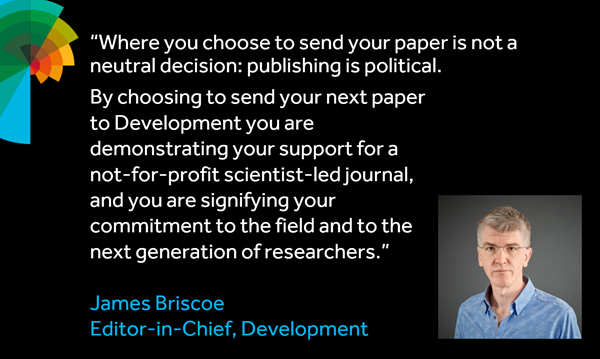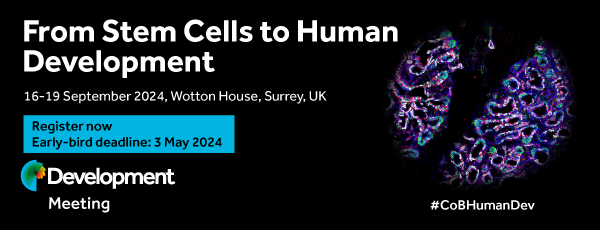Issues
-
Cover image
Cover Image

Cover: A three-dimensional reconstruction of an embryonic day 10.5 mouse from the front using microcomputed tomographic imaging. Images were acquired using a Bruker SKYSCAN 1272 at 3 μm/pixel, reconstructed using SkyScan NRecon, and visualised with CTVox and Imaris software. See Research article by Martínez Traverso et al. (dev200860).
- PDF Icon PDF LinkTable of contents
- PDF Icon PDF LinkIssue info
RESEARCH HIGHLIGHTS
DEVELOPMENTAL TWISTS
PERSPECTIVE
INTERVIEWS
REVIEW
Cerebellum lineage allocation, morphogenesis and repair: impact of interplay amongst cells
Summary: This Review gives an overview of cerebellum development and morphogenesis, which is orchestrated by the coordinated action of cells from various lineages, some of which exhibit plasticity upon injury.
STEM CELLS AND REGENERATION
Coupled myovascular expansion directs cardiac growth and regeneration
Highlighted Article: Coupled expansion of cardiac endothelial cells and cardiomyocytes within a myovascular niche regulates cardiac growth and regeneration in neonatal mice and likely humans.
RESEARCH REPORTS
Hemocytes are essential for Drosophila melanogaster post-embryonic development, independent of control of the microbiota
Highlighted Article: Hemocyte ablation in Drosophila melanogaster with a novel strong hemocyte-specific driver causes pupal lethality under germ-free conditions.
C. elegans srGAP is an α-catenin M domain-binding protein that strengthens cadherin-dependent adhesion during morphogenesis
Summary: Genetic, biochemical and imaging experiments demonstrate a role for SGRP-1 in stabilization of adherens junctions by binding to the HMP-1 M domain during C. elegans embryonic morphogenesis.
RESEARCH ARTICLES
Retrovirus-derived RTL5 and RTL6 genes are novel constituents of the innate immune system in the eutherian brain
Highlighted Article: RTL5 and RTL6 are eutherian-specific genes acquired from a retrovirus in microglia in the brain. They play important roles in pathogen clearance in the eutherian brain immune system.
Pivotal role of STIP in ovule pattern formation and female germline development in Arabidopsis thaliana
Summary:STIP plays a key role during ovule development in Arabidopsis thaliana by controlling integument formation and female germline progression.
Cell lineage specification and signalling pathway use during development of the lateral plate mesoderm and forelimb mesenchyme
Summary: This study establishes a transcriptional atlas of the cell fate decisions underlying LPM specification, subdivision and development of the chicken forelimbs.
LATS1/2 control TGFB-directed epithelial-to-mesenchymal transition in the murine dorsal cranial neuroepithelium through YAP regulation
Summary: Hippo signaling kinases LATS1 and LATS2 phosphorylate downstream effectors YAP/TAZ to regulate the TGFB-induced epithelial-to-mesenchymal transition in the migratory neural crest on the dorsal cranial neural tube.
Trim33 conditions the lifespan of primitive macrophages and onset of definitive macrophage production
Summary: Yolk sac-derived macrophages of zebrafish deficient in the transcriptional regulator Trim33 (Tif1γ) have a much reduced lifespan.
PBAF chromatin remodeler complexes that mediate meiotic transitions in mouse
Summary: The ARID2 and BRG1 components of the PBAF chromatin remodeling complex fulfill essential but distinct functions during gametogenesis.
Paternally inherited H3K27me3 affects chromatin accessibility in mouse embryos produced by round spermatid injection
Highlighted Article: Histone turnover-mediated reduction of H3K27me3 during spermiogenesis is important for chromatin accessibility in early mouse embryos.
TECHNIQUES AND RESOURCES
The dynamic proteome in Arabidopsis thaliana early embryogenesis
Highlighted Article: Profiling of proteome dynamics using nanoproteomics uncovers the relationship between RNAs and proteins during Arabidopsis thaliana early embryogenesis.
Breasi-CRISPR: an efficient genome-editing method to interrogate protein localization and protein–protein interactions in the embryonic mouse cortex
Summary: A new technique combining Easi-CRISPR with in utero electroporation allows efficient and rapid visualization of endogenous proteins in embryonic brain tissue.
A scalable phenotyping approach for female floral organ development and senescence in the absence of pollination in wheat
Summary: A new automated phenotyping method for stigma and ovary development in wheat highlights the potential for genetic variation that could benefit hybrid breeding.
Call for papers: Uncovering Developmental Diversity

Development invites you to submit your latest research to our upcoming special issue: Uncovering Developmental Diversity. This issue will be coordinated by our academic Editor Cassandra Extavour (Harvard University, USA) alongside two Guest Editors: Liam Dolan (Gregor Mendel Institute of Molecular Plant Biology, Austria) and Karen Sears (University of California Los Angeles, USA).
Choose Development in 2024

In this Editorial, Development Editor-in-Chief James Briscoe and Executive Editor Katherine Brown explain how you support your community by publishing in Development and how the journal champions serious science, community connections and progressive publishing.
Journal Meeting: From Stem Cells to Human Development

Register now for the 2024 Development Journal Meeting From Stem Cells to Human Development. Early-bird registration deadline: 3 May. Abstract submission deadline: 21 June.
Pluripotency of a founding field: rebranding developmental biology

This collaborative Perspective, the result of a workshop held in 2023, proposes a set of community actions to increase the visibility of the developmental biology field. The authors make recommendations for new funding streams, frameworks for collaborations and mechanisms by which members of the community can promote themselves and their research.
Read & Publish Open Access publishing: what authors say

We have had great feedback from authors who have benefitted from our Read & Publish agreement with their institution and have been able to publish Open Access with us without paying an APC. Read what they had to say.



